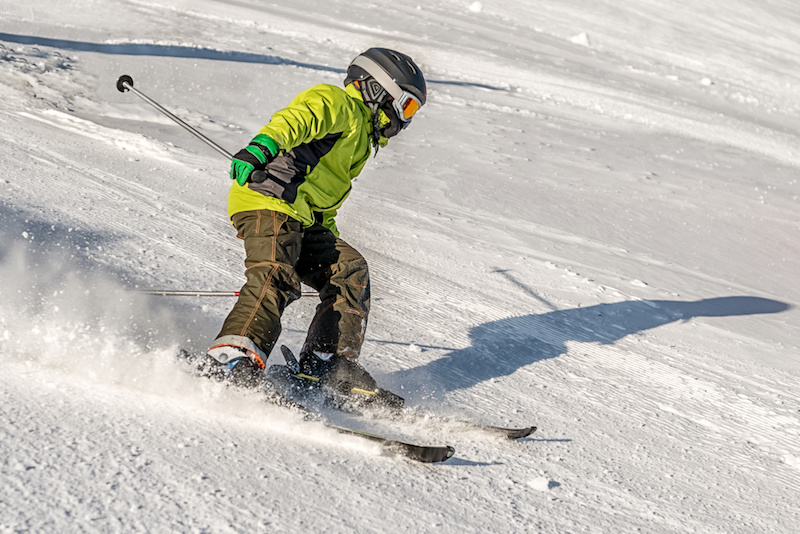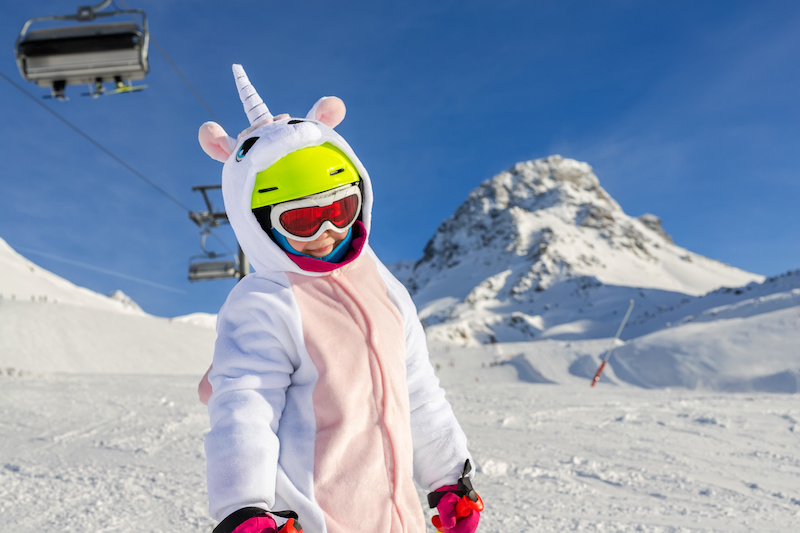Ski and snowboard safety: Helmet guide

They’re large and they mess up your hair. Nonetheless, more than 80 percent of skiers and snowboarders wore helmets during the 2017-2018 season. The rise in helmet use is welcome news for specialists in sports medicine and traumatic brain injury prevention, says Jessie Oldham, a postdoctoral researcher who focuses on sport-related concussion. Oldham recently shared information about helmets and head injuries with physical therapists, athletic trainers, parents, and athletes at the Micheli Center’s Quarterly Lecture Series.
How worried should skiers and snowboarders be about head injuries?
Skiers and snowboarders are admitted to the hospital for head injuries more often than for any other injury. Falling is the number one cause of skiing and snowboarding head injuries, including traumatic brain injuries and skull fractures. Collisions with non-moving objects such as trees and poles are the second most frequent cause.

You may think only daredevils who zoom down the mountain at top speed are at risk, but that’s not the case. “A large number of head injuries happen during falls on mild to moderate slopes,” says Oldham. “The risk for beginner and intermediate skiers and snowboarders is higher than most people realize.” Factors that increase the risk of head injury include being male, a beginner, between the ages of 15 and 19, and a snowboarder.
Anyone who skis or snowboards should wear a helmet according to Dr. Mark Proctor, neurosurgeon-in-chief and director of the Brain Injury Center. “We don’t talk enough about winter sport safety,” says Dr. Proctor. “I tell all my patients who ski or snowboard to have fun on the slopes, but please wear a helmet.”
How do helmets help?
Properly fitting helmets reduce the risk of ski and snowboard-related head injuries by 60 percent. They do so by absorbing the shock of a fall or collision. Even if a skier or snowboarder sustains a head injury, the injury will be less severe if their head is protected by a helmet.
Helmets do not completely prevent concussions, however. Concussions occur when a blow to the head causes the brain to move around inside of the skull. Unfortunately, no one has come up with head protection that prevents this from happening. Nonetheless, helmets are essential in protecting yourself and your family from skull fractures and other catastrophic head injuries.
Choosing the right helmet
To truly protect the person wearing it, a helmet needs to meet certain standards. When shopping for ski and snowboard helmets, keep the following things in mind.
The helmet should meet certification guidelines. Look for a sticker on the back of the helmet with the code, ASTM F2040 or CE EN 1077. Either code indicates that the helmet has been tested for safety standards such as shock-absorbing capacity, resistance to penetration, and durability.
The helmet should fit right. It’s a good idea to bring your child with you when you shop for their helmet. (Yes, this will ruin the surprise, but it’s worth it.) Have them try the helmet on and make sure there are no spaces between the padding and their head. The helmet should feel snug, but not so tight it will give your child a headache.
The helmet should cover the head correctly. Make sure the helmet protects your child’s forehead and covers the back of their head. It should sit 1 inch above their eyebrows in front and leave room for their head to move freely without rubbing against their neck in back.
The helmet should work with goggles. Have your child put the helmet on over their goggles. Make sure they can see forward and on both sides. The helmet should not push the goggles down into an uncomfortable position on their face.
Fasten the chin strap. Your child should be able to fit no more than one or two fingers between their chin and the strap. Ask them to open their mouth and yawn. If they feel the strap pull the helmet down slightly on their head, it’s a good fit. If they don’t, tighten the strap and try again. Or see if a different helmet will fit better.

When to replace a helmet
For older kids and adults who have stopped growing, experts recommend replacing a helmet every five years. For growing kids or those who subject their equipment to heavy wear and tear, the helmet may have to be replaced more often. If your child is in a serious crash while wearing the helmet or if it becomes damaged, replace it.
You can make helmets last longer with basic care:
- Store the helmet in an area that does not get too hot or too cold.
- Do not sit or lean on the helmet or store it under something heavy.
- Wash the helmet with mild detergent and warm water periodically. Let it dry completely before the next use.
Learn more about the Sports Medicine Division and the Brain Injury Center at Boston Children’s Hospital.
Additional information on Oldham’s concussion research in skiing and snowboarding is available on the Micheli Center for Sports Injury Prevention website.
Related Posts :
-

Questions to ask about your child’s orthopedic care
Maybe your child has an orthopedic injury and needs surgery, or maybe they need to be treated with a different ...
-

Engineered cartilage could turn the tide for patients with osteoarthritis
About one in seven adults live with degenerative joint disease, also known as osteoarthritis (OA). In recent years, as anterior ...
-

Care for a prince: One family’s inspiring journey for encephalocele repair
To hear Peter and Eunice of Kenya tell the story of their son, Prince, is to hear about the power ...
-

My story of bouncing back from osteochondritis dissecans
Injuries suck — no better way of putting it. The physical pain is terrible on its own, but emotionally they can ...





